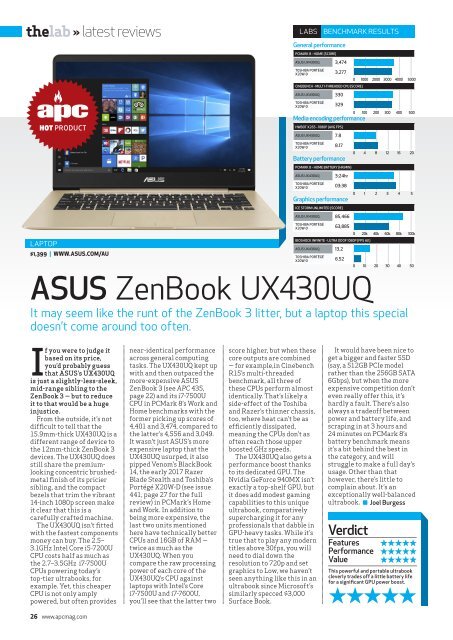Create successful ePaper yourself
Turn your PDF publications into a flip-book with our unique Google optimized e-Paper software.
thelab » latest reviews<br />
LABS BENCHMARK RESULTS<br />
General performance<br />
PCMARK 8 - HOME (SCORE)<br />
ASUS UX430UQ 3,474<br />
TOSHIBA PORTÉGÉ<br />
X20W-D 3,277<br />
0 1000 2000 3000 4000 5000<br />
CINEBENCH - MULTI-THREADED CPU (SCORE)<br />
ASUS UX430UQ 330<br />
TOSHIBA PORTÉGÉ<br />
X20W-D 329<br />
0 100 200 300 400 500<br />
Media encoding performance<br />
HWBOT X265 - 1080P (AVG FPS)<br />
ASUS UX430UQ 7.8<br />
TOSHIBA PORTÉGÉ<br />
X20W-D 8.17<br />
Battery performance<br />
PCMARK 8 - HOME BATTERY (HR:MIN)<br />
0 4 8 12 16 20<br />
ASUS UX430UQ 3:24hr<br />
TOSHIBA PORTÉGÉ<br />
X20W-D 03:38<br />
Graphics performance<br />
ICE STORM UNLIMITED (SCORE)<br />
0 1 2 3 4 5<br />
ASUS UX430UQ 85,466<br />
LAPTOP<br />
$1,399 | WWW.ASUS.COM/AU<br />
TOSHIBA PORTÉGÉ<br />
X20W-D 63,885<br />
0 20k 40k 60k 80k 100k<br />
BIOSHOCK INFINITE - ULTRA DDOF 1080P (FPS AV.)<br />
ASUS UX430UQ 13.2<br />
TOSHIBA PORTÉGÉ<br />
X20W-D 6.52<br />
0 10 20 30 40 50<br />
ASUS ZenBook UX430UQ<br />
It may seem like the runt of the ZenBook 3 litter, but a laptop this special<br />
doesn’t come around too often.<br />
If you were to judge it<br />
based on its price,<br />
you’d probably guess<br />
that ASUS’s UX430UQ<br />
is just a slightly-less-sleek,<br />
mid-range sibling to the<br />
ZenBook 3 — but to reduce<br />
it to that would be a huge<br />
injustice.<br />
From the outside, it’s not<br />
difficult to tell that the<br />
15.9mm-thick UX430UQ is a<br />
different range of device to<br />
the 12mm-thick ZenBook 3<br />
devices. The UX430UQ does<br />
still share the premiumlooking<br />
concentric brushedmetal<br />
finish of its pricier<br />
sibling, and the compact<br />
bezels that trim the vibrant<br />
14-inch 1080p screen make<br />
it clear that this is a<br />
carefully crafted machine.<br />
The UX430UQ isn’t fitted<br />
with the fastest components<br />
money can buy. The 2.5–<br />
3.1GHz Intel Core i5-7200U<br />
CPU costs half as much as<br />
the 2.7–3.5GHz i7-7500U<br />
CPUs powering today’s<br />
top-tier ultrabooks, for<br />
example. Yet, this cheaper<br />
CPU is not only amply<br />
powered, but often provides<br />
near-identical performance<br />
across general computing<br />
tasks. The UX430UQ kept up<br />
with and then outpaced the<br />
more-expensive ASUS<br />
ZenBook 3 (see <strong>APC</strong> 435,<br />
page 22) and its i7-7500U<br />
CPU in PCMark 8’s Work and<br />
Home benchmarks with the<br />
former picking up scores of<br />
4,401 and 3,474, compared to<br />
the latter’s 4,556 and 3,049.<br />
It wasn’t just ASUS’s more<br />
expensive laptop that the<br />
UX430UQ usurped, it also<br />
pipped Venom’s BlackBook<br />
14, the early <strong>2017</strong> Razer<br />
Blade Stealth and Toshiba’s<br />
Portégé X20W-D (see issue<br />
441, page 27 for the full<br />
review) in PCMark’s Home<br />
and Work. In addition to<br />
being more expensive, the<br />
last two units mentioned<br />
here have technically better<br />
CPUs and 16GB of RAM —<br />
twice as much as the<br />
UX430UQ. When you<br />
compare the raw processing<br />
power of each core of the<br />
UX430UQ’s CPU against<br />
laptops with Intel’s Core<br />
i7-7500U and i7-7600U,<br />
you’ll see that the latter two<br />
score higher, but when these<br />
core outputs are combined<br />
— for example,in Cinebench<br />
R15’s multi-threaded<br />
benchmark, all three of<br />
these CPUs perform almost<br />
identically. That’s likely a<br />
side-effect of the Toshiba<br />
and Razer’s thinner chassis,<br />
too, where heat can’t be as<br />
efficiently dissipated,<br />
meaning the CPUs don’t as<br />
often reach those upper<br />
boosted GHz speeds.<br />
The UX430UQ also gets a<br />
performance boost thanks<br />
to its dedicated GPU. The<br />
Nvidia GeForce 940MX isn’t<br />
exactly a top-shelf GPU, but<br />
it does add modest gaming<br />
capabilities to this unique<br />
ultrabook, comparatively<br />
supercharging it for any<br />
professionals that dabble in<br />
GPU-heavy tasks. While it’s<br />
true that to play any modern<br />
titles above 30fps, you will<br />
need to dial down the<br />
resolution to 720p and set<br />
graphics to Low, we haven’t<br />
seen anything like this in an<br />
ultrabook since Microsoft’s<br />
similarly specced $3,000<br />
Surface Book.<br />
It would have been nice to<br />
get a bigger and faster SSD<br />
(say, a 512GB PCIe model<br />
rather than the 256GB SATA<br />
6Gbps), but when the more<br />
expensive competition don’t<br />
even really offer this, it’s<br />
hardly a fault. There’s also<br />
always a tradeoff between<br />
power and battery life, and<br />
scraping in at 3 hours and<br />
24 minutes on PCMark 8’s<br />
battery benchmark means<br />
it’s a bit behind the best in<br />
the category, and will<br />
struggle to make a full day’s<br />
usage. Other than that<br />
however, there’s little to<br />
complain about. It’s an<br />
exceptionally well-balanced<br />
ultrabook. Joel Burgess<br />
Verdict<br />
Features<br />
Performance<br />
Value<br />
This powerful and portable ultrabook<br />
cleverly trades off a little battery life<br />
for a significant GPU power boost.<br />
26 www.apcmag.com


















